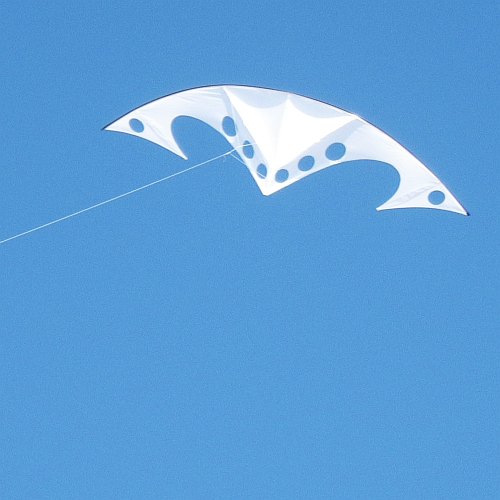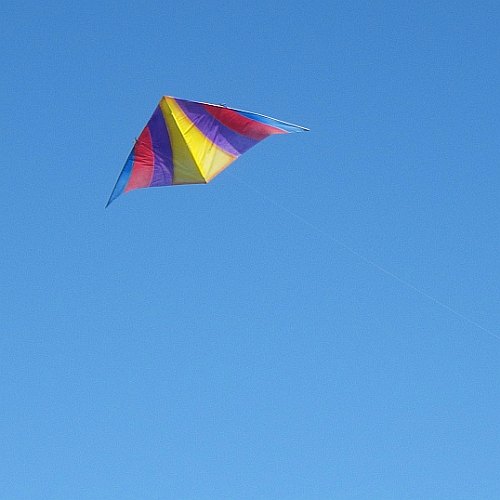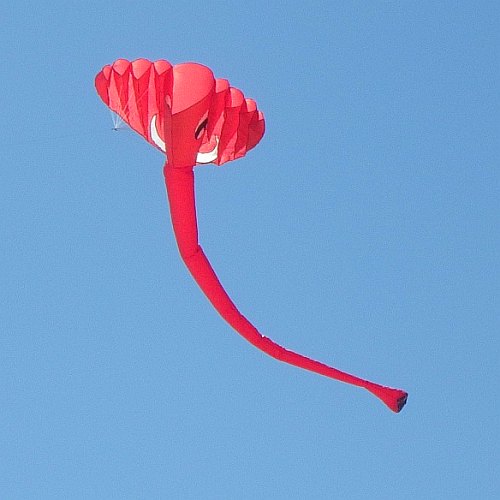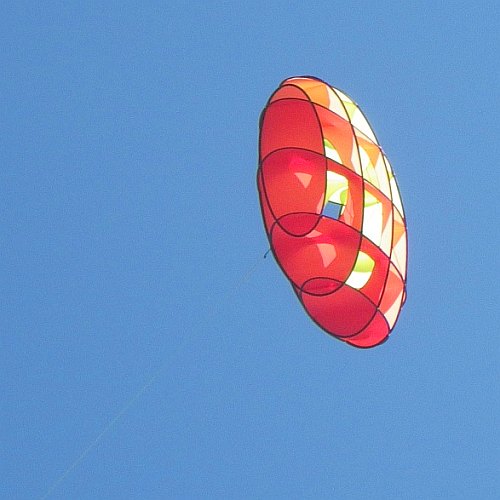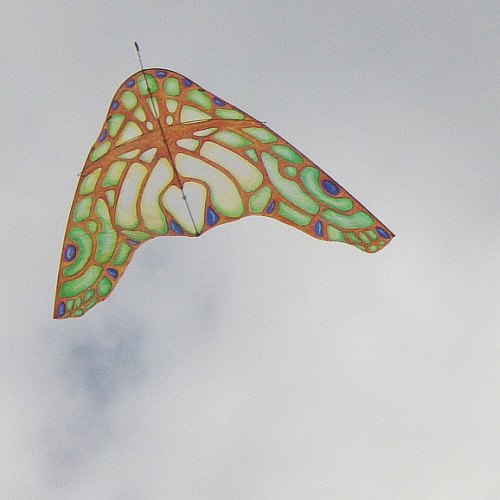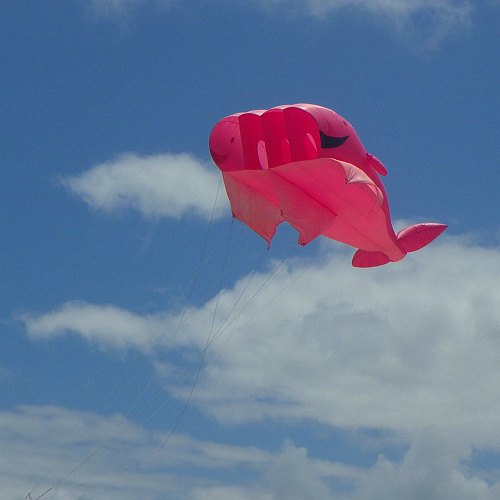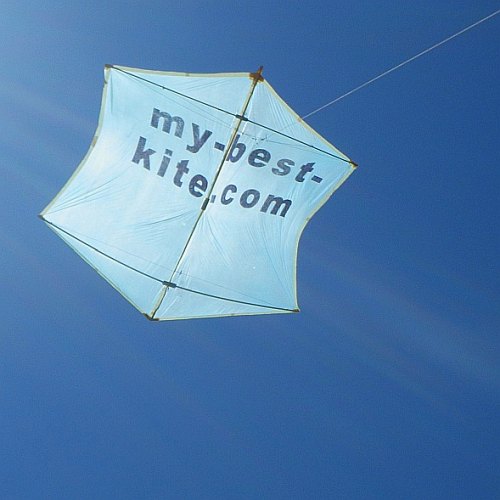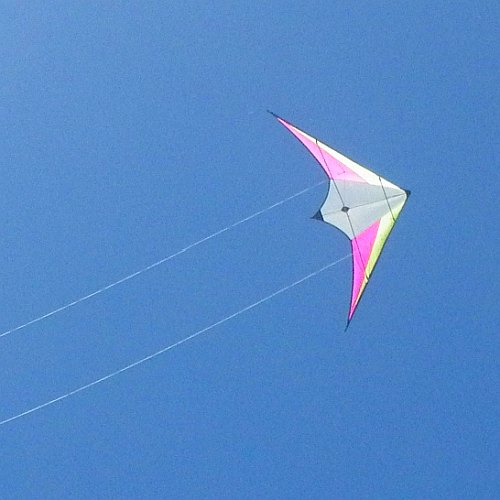AKFA Kite Fly Posts 2016
Adelaide Kite Flyers Association (AKFA). Every second Sunday of the month is a social fly day when (weather permitting) members meet to fly kites at Semaphore South.
These short flight reports once appeared in the site blog page although that blog is no longer being published. Just scroll down and stop at any kiting detail that appeals. :-) There's a photo gallery down near the bottom of this page too.
On this site, there's more kite-making info than you can poke a stick at. :-)
Want to know the most convenient way of using it all?
The Big MBK E-book Bundle is a collection of downloads—printable PDF files which provide step-by-step instructions for many kites large and small.
Every kite in every MBK series.
AKFA Kite Fly—December 2016
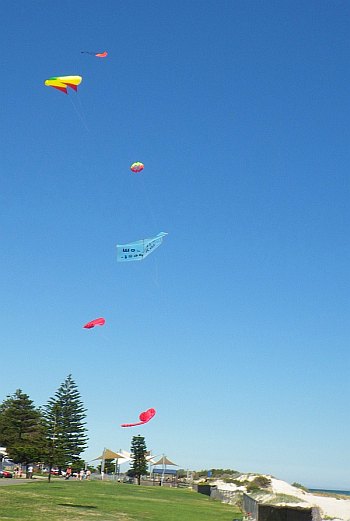 At the beach earlier in the year
At the beach earlier in the yearThe weather forecast was promising, and the promise was fulfilled.
The
first flying thing to come into view was a large trilobyte inflatable,
followed by another one tethered a little further downwind. These two
kites were to be the largest for a while—before being out-sized by the
addition of a long frill-necked-lizard inflatable to one of the flying
lines. Meanwhile, down on the sand...
A small star cellular
floated about serenely. This was an indication of the smoothness of the
prevailing southerly breeze, since the star will move about quite
erratically in most inland breezes. A couple of mid-sized parafoils were
up now as well, with some small items of line laundry dangling.
Crouching
down beside a brush fence, I found a handy spot on the grassy area to
rig the Red Roller—a dowel-and-Tyvek kite. On a short line, it was
straightforward to walk the kite down to the beach access point and
hence onto the sand.
A calico shopping bag with a few kilos of
sand poured in was sufficient to hold the Roller. Just over 30 meters (100 feet)
of line seemed appropriate, since the beach was not exactly deserted.
The roller kite stayed pretty much "nailed to the sky" for over an hour.
A
brightly decorated Dowel Dopero took a bit of trimming with shifting
the bridle knots and reattaching a sail tether. But finally it was up
and away and flying at a good angle.
Uncharacteristically, I
didn't check the wind speed on the day. But it seemed ideal for most
kites, being somewhere around the low end of moderate. It was in the high teens or low
twenties in kph, perhaps. Good flying was had, in sunny weather!
AKFA Kite Fly—August 2016
Despite the light conditions (which eventually deteriorated to very light), a good amount of flying was achieved by a variety of kites. Variety being the operative word!
Kites in flight included a small bird, large
parafoil, dowel delta, dowel diamond, small soft sled, parasail, and
medium four-cell parafoil. Plus there was a half-inflated monkey suspended by the
large parafoil.
The weather was pleasant enough, with cool air and plenty of sunshine.
The
newly-completed MBK Parafoil prototype #3 had its first flights and
proved capable of staying in the air tailless—but only just. After
getting a few inflight closeups, I put a small drogue on and let out
more line. The light-wind capability of the kite was a surprise. With three
straight lines in the design forming the upper surface curvature, the
kite in flight rounded this off to a nice smooth airfoil shape. It
seemed to be lifting well, considering the light air.
With back turned, kites sometimes get up to unpredictable activities.
Today
was such a day, when the large parafoil inexplicably sprouted a small
drogue, trailing from the exact centerline of the kite. It only took a
moment for me to recognize the drogue and realize that my own smaller
parafoil had descended onto the upper surface of the much larger kite!
By carefully taking in line, my own parafoil appeared, inflated, and
lifted off. That's something that will probably never happen again.
After
some time, the breeze lightened further and kites started coming down.
After packing away the parasail and parafoil, I brought out the Dowel
Diamond, which proceeded to keep company with the ripstop-sailed Dowel
Delta already flying.
It was a small event this month but certainly enough to educate the passing pedestrians that kite flying is not just for kids.
AKFA Kite Fly—June 2016
The wind wasn't sure what it wanted to do for a while there. Just before we arrived, apparently, the breeze was very light—only to suddenly freshen to three times the strength. Pack away the light-wind kites!
So instead of pulling out the Dowel Sode as planned, out came the new MBK
Parasail. It would appear that this kite will quickly become known as
the Jellyfish kite, going by several people's immediate response to
seeing it. That was completely unintentional, but the slightly milky painters'
drop-sheet plastic does give a great impression of the sea creature.
Together, of course, with all the bridle lines extending away from the
sail.
While flying the parasail, a couple of other kites went
up as more AKFA members arrived. Meanwhile, the breeze had started coming
from the east for a while and dropped out in strength. Eventually, though, the wind came back from the north and stayed at a good
sub-moderate strength for much of the afternoon.
This was the
perfect opportunity to put up quite a long train of MBK Multi-fly
Diamonds. Ten were tried this time—a personal best! With seven on the line, I
measured the pull, and it was peaking at only about 3.5 kilograms (8 pounds)
At
least a couple of stunt kites were up now, enjoying smooth winds of
adequate strength. A few more single-liners could be seen as well, plus
beachgoers were starting to stop and look around at all the action.
A
local KAP photographer suspended his camera right next to the diamond
train for ages. No doubt some interesting images will be popping up on
FaceBook soon! There was great weather and great flying until the average breeze-strength
finally sagged below 9 kph.
AKFA Kite Fly—April 2016
A quick check of the weather station convinced me that bringing a real light-wind kite would not be essential. To be on the safe side, however, we did have the 2-Skewer Barn Door in the car. On arrival at the beach near Fort Glanville at mid-afternoon, it turned out that the sea breeze was in.
Holding up the wind meter to the smooth southerly, it
registered about 18 kph while gusting to 23 kph. This was a bit heavy for the barn
door but we put it up anyway. Several other kites of all sizes were up
already, including a traction kite and a two-line stunt kite or two.
After
a few photos, short videos, plus some conversation with other fliers,
the little orange barn-door had had enough. One of the younger AKFA
members had rescued it from the dunes and was attempting to free the
20-pound Dacron line from bushes. With my help the kite was packed away
before more appropriate craft were brought out from the car—four
Multi-Fly Diamonds!
The wind speed was smack in the middle of
the diamonds' wind range, so they flew steadily at a 45-degree line
angle. Spaced less than 3 meters (10 feet) apart, the color-coordinated
kites flew as one. Short side-tails fluttered in contrast to the long-and-steady looped main tails.
With an hour or two of flying
time remaining, the sun broke out at last. Perfect! This was also handy for doing a little more photography. The final photos were taken
by Aren (ten), showing how easy the Multi-Fly Diamonds are to carry as a
group. Just slip your hand through the diamond holes, and grab all the
vertical spar tubes at once.
It was a fine outing with thoroughly pleasant autumn temperatures.
AKFA Kite Fly—March 2016
Fairly light winds were forecast, particularly around the middle of the day. There was also the chance of freshening winds as the afternoon wore on. This was pretty much what happened, with an early meter reading of 14 kph gusting to 17 kph and a later reading showing 19 kph gusting to 22 kph. Those are very usable wind speeds for your average kite flier!
As usual, I first spent
some time wandering around with the camera, capturing stills and videos
of all the action. Kites, large and small, were going up almost from
minute to minute. It was looking like a perfect day for single-line
kiting. As the breeze came up further, a number of stunt kites joined
the fray as well.
The sun blazed down from a largely blue sky,
ensuring a vibrant colorful spectacle for all the beachgoers—most of
whom would not have been expecting the mini kite festival in progress.
Finally,
I decided to give my newly repaired KAP (kite aerial photography) rig a
fly. I might as well get some practice in before the Adelaide
International Kite festival later in the month! That will be from the 25th to the 28th, to
be exact.
Up went the bamboo-skewer cage, dangling almost
motionless under a 100-pound Dacron line. The lifter was a 2 meter (7 foot)
Tyvek-and-carbon tailless diamond. By this time, the kite was in the
upper half of its wind range but still flying comfortably. Perfect!
Photos
were taken at ten-second intervals from about 50 feet off the sand to
nearly 300 feet altitude. Due to distance, only the largest kites were
visible in the photos. Also, many kites were flying fairly low and hence
had either sand, grass, or trees as a background.
Perhaps we KAPers all had the same idea regarding the upcoming festival; no less than three rigs were in the air at once today!
AKFA Kite Fly—Februray 2016
Weather-wise, it could hardly have been better. A smooth southerly was coming off the ocean, making just a slight angle with the roughly north-south orientation of the beach. Not long after arriving, I measured the breeze at about 17 kph and gusting to 22 kph. A fair amount of puffy cumulus cloud was about, but for most of the time the sun shone strongly.
Initially,
just a large parafoil was up. It was shortly followed by the ever-present
small pterodactyl and another parafoil. After wandering around taking
copious photos and videos, it was my turn with the 2-meter (7-foot) tall Carbon
Diamond. The tailless kite soared to a high angle on its 100-pound
line, anchored by a calico bag half filled with sand.
Meanwhile,
a number of other AKFA members turned up and started getting kites in
the air. As far as line laundry goes, there was a monkey, an Aussie flag,
and a small octopus. The octopus was probably capable of flying on its
own but made a fine display hanging off the flying line of a large
black parafoil. Oh, and there were enormous geckos as well—two of them,
under different parafoils.
Eventually, I got around to
grabbing a handful of Multi-Fly Diamonds and put them up one by one on a
100-pound Dacron line. This time, slightly closer inter-kite spacing
was tried. There were no problems at all, thanks to the smoothness of the breeze!
In
the end, just about the full range of commonly seen single-line kite
designs were in the air. Deltas, diamonds, boxes, novelty, and parafoils were all aloft.
There was something for everyone, as beachgoers walked through and had a look at
the aerial display.
AKFA Kite Fly—January 2016
It was more like the AKFA mass kite sink-out, unfortunately... On approaching the beach by car, a couple of large kites could be seen, comfortably floating over the grassed area. Minutes later, however, they were both down and the guys were scrambling for lighter-wind kites to try. I had some Multi-Fly Diamonds on board, with another tail configuration all set for a tryout. It was not to be, not today.
Instead, out came
the trusty Multi-Dowel Sled. This kite is 2.4 meters (8 feet) in height when plugged
together, and it's great in very light air. In no time, it was rigged and
several attempts were made to launch. The dowel drums securing the spars
were a little loose from many hours of flight time over several years,
but what could possibly go wrong on such a light day with little direct
sunlight to heat the ground?
Finally, the big sled took to the
sky, being climbed out with the help of a gentle puff of air and much
walking back and working the line. Above 100 feet it was just holding
its own, but a list to the left was not helping. So down it came for a
quick bridle-knot adjustment. With some help from another AKFA
member, a long-line launch soon had the ponderous blue sled back up,
inching past the light-gray backdrop of mid-level cloud.
For
quite some time, the sled plus a large delta conyne were able to hang up
there at just under 300 feet of altitude. Finally, there was a bit of
excitement...
The cloud cover burnt off and the sun blazed
down. Strong thermal activity began, and soon the Multi-Dowel Sled began
to overfly on its 200-pound Dacron line. While directly in line with the
early-afternoon sun, the kite flew out of the rising air and in all the
free-falling shuffling around of the plastic and dowel, all three drums
worked loose and the kite folded in half! Amazingly, it continued to fly
for a while with the upper half folded back over the lower half. A
quick pull-in of all the line was all that could be done, but on
retrieving the kite (thanks Mike) no damage could be seen.
At least something flew for while!
Memories From 2016
Tap or click on any image below to start the gallery:
As mentioned earlier, there's more kite making on this site than you can poke a stick at. :-)
Want to know the most convenient way of using it all?
The Big MBK E-book Bundle is a collection of downloads—printable PDF files that provide step-by-step instructions for many kites large and small.
That's every kite in every MBK series.

